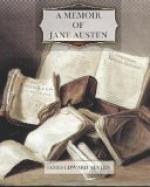might have appeared mean and uninteresting to an ordinary observer; but the adept in church architecture would have known that it must have stood there some seven centuries, and would have found beauty in the very narrow early English windows, as well as in the general proportions of its little chancel; while its solitary position, far from the hum of the village, and within sight of no habitation, except a glimpse of the gray manor-house through its circling screen of sycamores, has in it something solemn and appropriate to the last resting-place of the silent dead. Sweet violets, both purple and white, grow in abundance beneath its south wall. One may imagine for how many centuries the ancestors of those little flowers have occupied that undisturbed, sunny nook, and may think how few living families can boast of as ancient a tenure of their land. Large elms protrude their rough branches; old hawthorns shed their annual blossoms over the graves; and the hollow yew-tree must be at least coeval with the church.
[Steventon Manor House: ManorHouse.jpg]
But whatever may be the beauties or defects of the surrounding scenery, this was the residence of Jane Austen for twenty-five years. This was the cradle of her genius. These were the first objects which inspired her young heart with a sense of the beauties of nature. In strolls along those wood-walks, thick-coming fancies rose in her mind, and gradually assumed the forms in which they came forth to the world. In that simple church she brought them all into subjection to the piety which ruled her in life, and supported her in death.
The home at Steventon must have been, for many years, a pleasant and prosperous one. The family was unbroken by death, and seldom visited by sorrow. Their situation had some peculiar advantages beyond those of ordinary rectories. Steventon was a family living. Mr. Knight, the patron, was also proprietor of nearly the whole parish. He never resided there, and consequently the rector and his children came to be regarded in the neighbourhood as a kind of representatives of the family. They shared with the principal tenant the command of an excellent manor, and enjoyed, in this reflected way, some of the consideration usually awarded to landed proprietors. They were not rich, but, aided by Mr. Austen’s powers of teaching, they had enough to afford a good education to their sons and daughters, to mix in the best society of the neighbourhood, and to exercise a liberal hospitality to their own relations and friends. A carriage and a pair of horses were kept. This might imply a higher style of living in our days than it did in theirs. There were then no assessed taxes. The carriage, once bought, entailed little further expense; and the horses probably, like Mr. Bennet’s, were often employed on farm work. Moreover, it should be remembered that a pair of horses in those days were almost necessary, if ladies were to move about at all; for neither the condition of the roads nor the style of carriage-building admitted of any comfortable vehicle being drawn by a single horse. When one looks at the few specimens still remaining of coach-building in the last century, it strikes one that the chief object of the builders must have been to combine the greatest possible weight with the least possible amount of accommodation.




